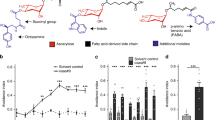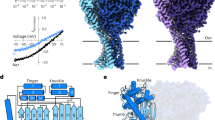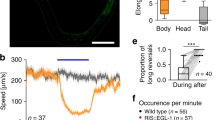Abstract
The neurotransmitter and neuromodulator serotonin (5-HT) functions by binding either to metabotropic G-protein-coupled receptors (for example, 5-HT1, 5-HT2, 5-HT4 to 5-HT7), which mediate ‘slow’ modulatory responses through numerous second messenger pathways1, or to the ionotropic 5-HT3 receptor, a non-selective cation channel that mediates ‘fast’ membrane depolarizations2. Here we report that the gene mod-1 (for modulation of locomotion defective) from the nematode Caenorhabditis elegans encodes a new type of ionotropic 5-HT receptor, a 5-HT-gated chloride channel. The predicted MOD-1 protein is similar to members of the nicotinic acetylcholine receptor family of ligand-gated ion channels, in particular to GABA (γ-aminobutyric acid)- and glycine-gated chloride channels. The MOD-1 channel has distinctive ion selectivity and pharmacological properties. The reversal potential of the MOD-1 channel is dependent on the concentration of chloride ions but not of cations. The MOD-1 channel is not blocked by calcium ions or 5-HT3a-specific antagonists but is inhibited by the metabotropic 5-HT receptor antagonists mianserin and methiothepin. mod-1 mutant animals are defective in a 5-HT-mediated experience-dependent behaviour3 and are resistant to exogenous 5-HT, confirming that MOD-1 functions as a 5-HT receptor in vivo.
This is a preview of subscription content, access via your institution
Access options
Subscribe to this journal
Receive 51 print issues and online access
$199.00 per year
only $3.90 per issue
Buy this article
- Purchase on Springer Link
- Instant access to full article PDF
Prices may be subject to local taxes which are calculated during checkout





Similar content being viewed by others
References
Martin, G. R., Eglen, R. M., Hamblin, M. W., Hoyer, D. & Yocca, F. The structure and signalling properties of 5-HT receptors: an endless diversity? Trends Pharmacol. Sci. 19, 2–4 (1998 ).
Maricq, A. V., Peterson, A. S., Brake, A. J., Myers, R. M. & Julius, D. Primary structure and functional expression of the 5HT3 receptor, a serotonin-gated ion channel. Science 254, 432–437 (1991).
Sawin, E. R., Ranganathan, R. & Horvitz, H. R. C. elegans locomotory rate is modulated by the environment through a dopaminergic pathway and by experience through a serotonergic pathway. Neuron 26, 619– 631 (2000).
Horvitz, H. R., Chalfie, M., Trent, C., Sulston, J. E. & Evans, P. D. Serotonin and octopamine in the nematode Caenorhabditis elegans. Science 216, 1012– 1014 (1982).
The C. elegans Sequencing Consortium. Genome sequence of the nematode C. elegans: a platform for investigating biology. Science 282, 2012– 2018 (1998).
Krause, M. & Hirsh, D. A trans-spliced leader sequence on actin mRNA in C. elegans. Cell 49, 753–761 (1987).
Liu, L. X. et al. High-throughput isolation of Caenorhabditis elegans deletion mutants. Genome Res. 9, 859– 867 (1999).
Jansen, G., Hazendonk, E., Thijssen, K. L. & Plasterk, R. H. Reverse genetics by chemical mutagenesis in Caenorhabditis elegans. Nature Genet. 17, 119– 121 (1997).
Sumikawa, K. & Gehle, V. M. Assembly of mutant subunits of the nicotinic acetylcholine receptor lacking the conserved disulfide loop structure. J. Biol. Chem. 267, 6286– 6290 (1992).
Karlin, A. & Akabas, M. H. Toward a structural basis for the function of nicotinic acetylcholine receptors and their cousins. Neuron 15, 1231–1244 ( 1995).
Cooper, J. R., Bloom, F. E. & Roth, R. H. The Biochemical Basis of Neuropharmacology (Oxford Univ. Press, New York, 1996).
Hardie, R. C. A histamine-activated chloride channel involved in neurotransmission at a photoreceptor synapse. Nature 339, 704– 706 (1989).
McClintock, T. S. & Ache, B. W. Histamine directly gates a chloride channel in lobster olfactory receptor neurons. Proc. Natl Acad. Sci. USA 86, 8137– 8141 (1989).
Cully, D. F. et al. Cloning of an avermectin-sensitive glutamate-gated chloride channel from Caenorhabditis elegans. Nature 371, 707–711 (1994).
Adelsberger, H., Lepier, A. & Dudel, J. Activation of rat recombinant α1β 2γ2S GABAA receptor by the insecticide ivermectin. Eur. J. Pharmacol. 394, 163– 170 (2000).
Krause, R. M. et al. Ivermectin: a positive allosteric effector of the α7 neuronal nicotinic acetylcholine receptor. Mol. Pharmacol. 53, 283–294 (1998).
Davies, P. A. et al. The 5-HT3B subunit is a major determinant of serotonin-receptor function. Nature 397, 359– 363 (1999).
Downie, D. L. et al. Pharmacological characterization of the apparent splice variants of the murine 5-HT3 R-A subunit expressed in Xenopus laevis oocytes. Neuropharmacology 33, 473– 482 (1994).
Aizenberg, D. et al. Mianserin, a 5-HT2a/2c and alpha 2 antagonist, in the treatment of sexual dysfunction induced by serotonin reuptake inhibitors. Clin. Neuropharmacol. 20, 210–214 (1997).
Granas, C. & Larhammar, D. Identification of an amino acid residue important for binding of methiothepin and sumatriptan to the human 5-HT(1B) receptor. Eur. J. Pharmacol. 380, 171–181 (1999).
Weber, W. Ion currents of Xenopus laevis oocytes: state of the art. Biochim. Biophys. Acta. 1421, 213– 233 (1999).
Bormann, J., Hamill, O. P. & Sakmann, B. Mechanism of anion permeation through channels gated by glycine and gamma-aminobutyric acid in mouse cultured spinal neurones. J. Physiol. (Lond.) 385, 243– 286 (1987).
Chalfie, M., Tu, Y., Euskirchen, G., Ward, W. W. & Prasher, D. C. Green fluorescent protein as a marker for gene expression. Science 263, 802–805 (1994).
Shaham, S. & Horvitz, H. R. Developing Caenorhabditis elegans neurons may contain both cell-death protecture and killer activities. Genes Dev. 10, 578–591 (1996).
Lessmann, V. & Dietzel, I. D. Development of serotonin-induced ion currents in identified embryonic Retzius cells from the medicinal leech (Hirudo medicinalis). J. Neurosci. 11, 800–809 (1991).
Lessmann, V. & Dietzel, I. D. Two kinetically distinct 5-hydroxytryptamine-activated Cl- conductances at Retzius P-cell synapses of the medicinal leech. J. Neurosci. 15, 1496– 1505 (1995).
Brenner, S. The genetics of Caenorhabditis elegans. Genetics 77, 71–94 (1974).
Mello, C. C., Kramer, J. M., Stinchcomb, D. & Ambros, V. Efficient gene transfer in C. elegans: extrachromosomal maintenance and integration of transforming sequences. EMBO J. 10, 3959–3970 (1991).
Morrill, J. A. & Cannon, S. C. Effects of mutations causing hypokalaemic periodic paralysis on the skeletal muscle L-type Ca2+ channel expressed in Xenopus laevis oocytes. J. Physiol. (Lond.) 520, 321–336 (1999).
Hayward, L. J., Brown, R. H. Jr & Cannon, S. C. Inactivation defects caused by myotonia-associated mutations in the sodium channel III-IV linker. J. Gen. Physiol. 107, 559–576 ( 1996).
Acknowledgements
We thank N. Buttner, D. Omura and P. Reddien for suggestions concerning this manuscript; G. Moulder and R. Barstead for help in isolating the mod-1(ok103) allele; L. Liu and C. Johnson for sharing the mod-1(nr2043) allele before publication; and D. Julius for the 5-HT3a cDNA clone. This work was supported by a grant from the United States Public Health Service (H.R.H.). R.R. is supported by a Howard Hughes Medical Institute predoctoral fellowship. H.R.H. is an Investigator of the Howard Hughes Medical Institute.
Author information
Authors and Affiliations
Corresponding author
Supplementary information
Rights and permissions
About this article
Cite this article
Ranganathan, R., Cannon, S. & Horvitz, H. MOD-1 is a serotonin-gated chloride channel that modulates locomotory behaviour in C. elegans. Nature 408, 470–475 (2000). https://doi.org/10.1038/35044083
Received:
Accepted:
Issue Date:
DOI: https://doi.org/10.1038/35044083
This article is cited by
-
The diverse family of Cys-loop receptors in Caenorhabditis elegans: insights from electrophysiological studies
Biophysical Reviews (2023)
-
Moderate intensity of static magnetic fields can alter the avoidance behavior and fat storage of Caenorhabditis elegans via serotonin
Environmental Science and Pollution Research (2022)
-
Transcriptional analysis of the response of C. elegans to ethanol exposure
Scientific Reports (2021)
-
Serotonin promotes exploitation in complex environments by accelerating decision-making
BMC Biology (2016)
-
Competitive antagonists facilitate the recovery from desensitization of α1β2γ2 GABAA receptors expressed in Xenopus oocytes
Acta Pharmacologica Sinica (2016)
Comments
By submitting a comment you agree to abide by our Terms and Community Guidelines. If you find something abusive or that does not comply with our terms or guidelines please flag it as inappropriate.



